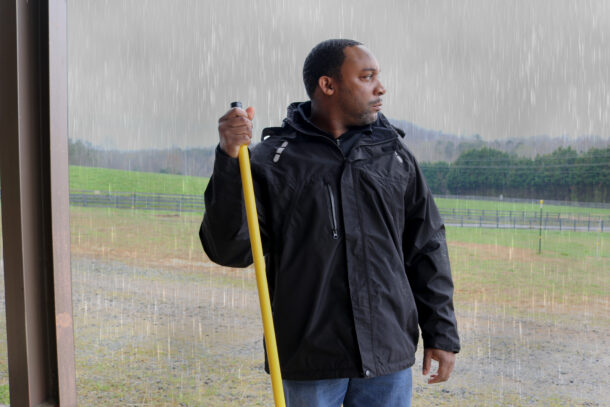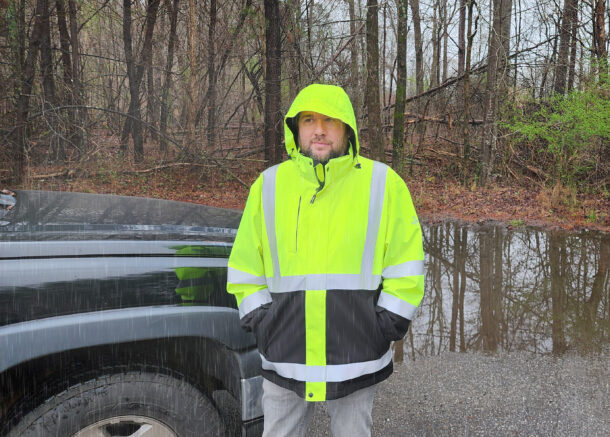By Paula Glover
Rain showers can add an extra layer of complexity to outdoor work, especially for those in the skilled trades. During the spring and fall, when the weather becomes more unpredictable, it’s crucial for workers, managers, and small business owners in construction, grading, electrical, plumbing, HVAC, and related fields to prioritize safety in wet conditions. From choosing the right raingear to staying weather-aware, here are five essential tips to keep your team safe and productive on rainy workdays.

1. Choose Durable Raingear Designed for Work
When it comes to working in the rain, having the right gear can make all the difference. Waterproof workwear goes a long way toward keeping you dry and comfortable on a soggy jobsite.
Look for rain jackets and pants made from durable materials with sealed seams and waterproof layers to prevent water penetration. Ideally, raingear should not only repel rain but also provide breathability to prevent overheating and moisture buildup inside the garment when you’re working up a sweat.
For added safety in dim, rainy conditions, consider investing in high-visibility rainwear to enhance your visibility in low-light conditions and reduce the risk of accidents on the job site.
In spring and fall, when temperatures and conditions vary widely throughout the workday, it’s important to look for rain gear that offers the added flexibility of removable layers and built-in features like roll-out hoods. For example, RefrigiWear offers a 3-in-1 Rainwear Jacket in black or high-visibility yellow that delivers comfortable protection for working outside on rainy days. The lightweight, 100% waterproof outer jacket features a roll-in hood for versatility. Meanwhile, the inner puffer-style jacket provides warmth and insulation and can stand alone.
Whether it’s a light drizzle or a heavy downpour, having the right raingear can make the difference between a productive workday and a complete washout.
2. Protect Your Feet
Don’t skimp on protecting your feet in wet work conditions. Wet surfaces increase the risk of slips, trips, and falls, so it’s essential to invest in comfortable and supportive waterproof work boots or safety shoes.
Look for waterproof work shoes and boots with non-slip soles that provide traction on slippery surfaces. These shoes should also offer adequate support and cushioning to reduce fatigue and prevent foot-related injuries during long hours on the job.
When you’re trying to outwork wet weather, you can’t ignore the risk of trench foot, a painful condition caused by prolonged exposure to wet and cold conditions. Waterproof footwear not only keeps your feet dry but also helps regulate temperature, minimizing the risk of trench foot, cold stress, frostbite or worse weather-related injuries. Prioritizing foot protection means prioritizing stability, comfort, and safety while working in rainy weather.
3. Protect Your Hands
When it comes to handling tools and equipment in rainy weather, a secure grip is everything. Wet conditions can compromise your grip strength and increase the risk of accidents. To mitigate these risks, invest in waterproof gloves designed specifically for working in wet conditions.
Waterproof gloves are made with specialized materials and grip patterns that help you hold equipment and tools securely, even in the rain. Whether you’re handling power tools, operating machinery, or performing tasks that require extreme attention to detail, waterproof work gloves provide the dexterity and protection you need to get the job done.
Waterproof gloves enhance safety and productivity on the job site by keeping your hands dry and enhancing your grip. Proper hand protection is vital to maintaining workplace safety in rainy weather – when you’ve got a grip on the right gear, working in the rain becomes a breeze.

4. Always Stay Weather-Aware
Just because you’ve got the gear to stay dry while working in a downpour doesn’t mean you should. Being weather-aware is key to staying safe when working outdoors, especially during popup thundershowers.
Monitor your local weather forecasts regularly and be prepared to adjust your work schedule accordingly. Rain showers can intensify quickly, bringing the risk of lightning strikes, flash floods, and strong winds. By keeping an eye on weather reports and conditions in your area, you can make informed decisions to protect yourself and your team from severe weather.
In addition to monitoring forecasts, pay attention to environmental cues that indicate changes in weather patterns. Darkening skies, distant thunder, and gusty winds are all signs of impending rain showers. If lightning is detected or flash flood warnings are issued for your area, it’s important to seek shelter immediately and suspend outdoor activities until conditions improve.
By staying vigilant and proactive, you can minimize the risk of weather-related accidents and ensure the safety of everyone on the job site. After all, while OSHA may not have specific standards for workplace safety in the rain, they do require employers to provide an overall safe workplace.
5. Keep Your Raingear & Supplies Handy
For workers who are constantly on the move, remember that packable rain gear is a practical solution for staying dry and comfortable in a variety of wet conditions. These lightweight and compact garments can be easily zipped into a pouch and tucked into a toolbox or backpack so you’re always prepared for sudden changes in weather.
Whether you’re caught in a passing shower or facing prolonged rainfall, packable rain gear provides instant protection without weighing you down. Look for options like the RefrigiWear Midweight Rainwear Set, a packable rain suit designed for convenience and functionality. With features such as an adjustable hood, elastic cuffs and reinforced seams, this rain suit offers reliable protection against the elements while allowing breathability and freedom of movement.
It’s also a good idea to keep a couple of waterproof tarps or plastic sheets stowed with your raingear. When showers spring up, you’ll be able to quickly cover any vulnerable supplies or equipment and minimize any damage to valuable materials.
When Rain Pours Down, It’s Time to Gear Up
Working safely in the rain requires careful preparation, awareness of changing conditions, and the proper protective gear. By investing in quality waterproof workwear, prioritizing foot protection and grip, staying weather-aware, and embracing packable rain gear, workers, managers, and business owners can mitigate risks and ensure a safe and productive work environment.
 About Paula Glover
About Paula Glover
Paula Glover is the Marketing Communications Director for RefrigiWear, the leading manufacturer of insulated workwear, safety apparel and personal protective equipment (PPE) for extreme cold work environments. Learn more at pro.refrigiwear.com.

 About Paula Glover
About Paula Glover


Join the conversation: